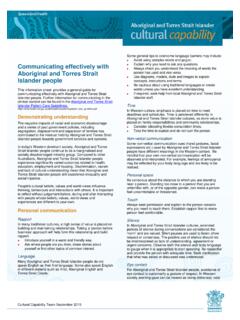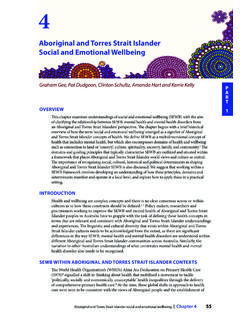Transcription of Working with Aboriginal and Torres Strait Islander young …
1 Working with Aboriginal and Torres Strait Islander young people and their families The Healing Foundation is committed to supporting people to better understand trauma and works with communities to lead their own healing solutions. This fact sheet has been developed in partnership with child and adolescent psychiatrist Prof Helen Milroy to help increase awareness and understanding of intergenerational trauma. It has been designed to be used in conjunction with the Healing Foundation's Intergenerational Trauma animation. Introduction Working effectively with Aboriginal and Torres Strait Islander young people and their families requires a comprehensive approach. This includes: developing a cultural framework for understanding Aboriginal and Torres Strait Islander families and communities understanding the historical legacy of colonisation having a multidimensional approach to health and wellbeing having regard to child development understanding the contemporary risk and protective factors, and social determinants as they apply to Aboriginal and Torres Strait Islander children.
2 Given the complexity of life and development for Aboriginal and Torres Strait Islander children and young people, it may be difficult to work out what all the issues are and where an effective intervention can be applied, as well as who is responsible. However, if a comprehensive assessment approach is developed, intervention points can be identified and worked through. One of the common problems encountered when Working with children and young people in general is developing an understanding of what drives behaviour, rather than labelling the behaviour itself. This is particularly problematic when Working with intergenerational trauma within a cross cultural context. 1. Developmental risk When compared with the general population, Aboriginal and Torres Strait Islander children and young people: have a greater exposure to general risk factors for development and stressful life events are at greater risk for emotional and behavioural difficulties have higher rates of hospital admission for mental health problems have higher rates of suicide have higher rates of incarceration have a higher rate of removal under the care of child protection services are more likely to have low birth weight, physical health problems and developmental disability have poorer educational outcomes.
3 Combined with these risks are family and community factors, which include exposure to racism and discrimination, a higher risk for health and mental health problems, shortened life expectancy, poverty, and poor housing. As a result of the legacy of colonisation and lower life expectancy, the Aboriginal and Torres Strait Islander population has a third world age structure. This means there are relatively more children, fewer adults and very few elders in the community. This reduces the availability of healthy adults to care for children, reduces the number of grandparents available to support parents and children with the relative burden of care falling to young people to look after family. Strengths and protective factors There are however many strengths and protective factors which have allowed Aboriginal and Torres Strait Islander children and young people to survive despite high levels of adversity.
4 These include: strong cultural identity and belief systems extensive kinship systems which are socially inclusive broader attachment models cultural and spiritual strengths including connection to country and ancestry strong child rearing practices early autonomy and self-reliance cultural ways of learning role of traditional healers and ceremony focus on healing. It is important to identify how these strengths can be supported and utilised to enhance the capacity of Aboriginal and Torres Strait Islander children and young people to develop resilience and reach their full potential. 2. Multidimensional model of health and wellbeing The Dance of Life model identifies five dimensions of life and development which include: physical psychological and emotional social spiritual cultural. Within these are layers of complexity which include the impact of the historical legacy, the cultural or traditional view, the contemporary issues, gaps in knowledge and finally the range of possible solutions.
5 This matrix builds from the strengths and protective factors of culture, through the devastating impacts of colonisation, to arrive at the contemporary understanding of the high levels of disadvantage and ill health seen today. There are still gaps in our knowledge as to the intergenerational impact, pathways for healing and culturally safe practices within our systems of care, health and education. The solutions range from what is needed for a healthy start to life through to resolving issues of self-determination and Native Title. They also involve the role of the individual, family, community and political system. Without a clear understanding of the historical legacy of trauma, powerlessness and grief and the intergenerational impact, it is impossible to make sense of the current levels of disadvantage, distress and trauma present today. By understanding the complexity of issues facing Aboriginal and Torres Strait Islander children and young people, individuals can identify their role in making a difference.
6 Create a check list to identify where the issues are occurring and consider the following: Physical health and development: Is there a physical or development issue that needs to be taken into account? Children are not always aware if they are unwell, for example glue ear can go undiagnosed for a significant period of time which impacts on the child's ability to develop language and be able to hear instruction in the classroom. Inadequate nutrition may also be impacting on general health. Anaemia in adolescent girls is a common condition and leads to tiredness and lethargy which compromises learning. Language disorders are often missed within a cross cultural context especially if the child speaks several languages. Physical health and developmental disorders can impair learning and lead to behavioural and emotional problems if not assessed and managed appropriately. If there is any doubt a good health and developmental screen is appropriate.
7 Psychological: emotional and cognitive development Given the high rate of adverse childhood experiences Aboriginal and Torres Strait Islander children and young people are exposed to, the impact of trauma on behaviour, emotional development and learning can be significant. This requires careful assessment and management to be effective. Trauma can cause problems with attention and concentration, memory and language development as well as problems with behaviour and emotional regulation. For boys in particular but for girls as well, aggressive behaviour can be a result of traumatic stress as can withdrawal and depression. Anxiety, restlessness and acting out behaviour are common manifestations of traumatic stress in children and impact on learning. 3. Other issues such as the impact of grief and loss can also contribute to poor school attendance and achievement. Transgenerational trauma can impact on psychological development and the sense of safety and trust in others.
8 Does the child or young person require a culturally safe psychological or mental health assessment? Social: Poor housing, overcrowding and inadequate supervision may impact on a child's ability to perform at school or complete homework. Family and community issues may also be affecting a child's wellbeing. Some young people have a hidden sense of homelessness by moving around a variety of homes of friends and family. If there is a high burden of health problems within a family system, the child or young person may assume the carer's role for the family. Is there a broader family, community or social issue impacting on the child or young person? Has the impact of transgenerational trauma been considered? Does the family require a greater level of support or engagement? Cultural/spiritual Cultural and spiritual beliefs and practices can impact on the way Aboriginal and Torres Strait Islander children and young people view the world, react to situations and develop coping skills.
9 Cultural and spiritual experiences need to be understood in the context of the cultural belief system. Talking to ancestors for example and grieving for country may be normal cultural experiences. This needs to be taken into account when observing behaviour. Are there cultural or spiritual issues present? Does the Aboriginal and Torres Strait Islander child or young person have adequate access to cultural supports? Is their cultural identity supported within the school or community environment? Systemic Aboriginal and Torres Strait Islander children and young people continue to experience racism and discrimination across a variety of settings. Given the historical legacy, racism and discrimination needs to be considered as a factor. Does the school accept and promote a strong Aboriginal and Torres Strait Islander identity and culture within the school community? How is the Aboriginal and Torres Strait Islander community included within the school environment?
10 How is the history of colonisation taught in the curriculum? Socio-political There are times when Aboriginal and Torres Strait Islander communities feel challenged such as during community wide interventions, negative publicity or being viewed as problems. This can impact on Aboriginal and Torres Strait Islander children and young people's self-esteem and identity and challenge their sense of safety in society. How are Aboriginal and Torres Strait Islander children and young people supported during these public events? Questions to guide your work Where is the real change needed? What role can you play to improve the situation? Who else needs to be involved? Who else needs to be better informed? How would you promote system reform? 4. For example: If you work in a school as a teacher or school counsellor you could: take time to understand the context and stressors that may be present in the families of the children and young people you work with understand that children's behaviours may be a result of the impact of many factors that they are coping with seek to offer support to families and engage with them by using the cultural supports available to you, such as the Aboriginal and Torres Strait Islander educators or liaison officers.








